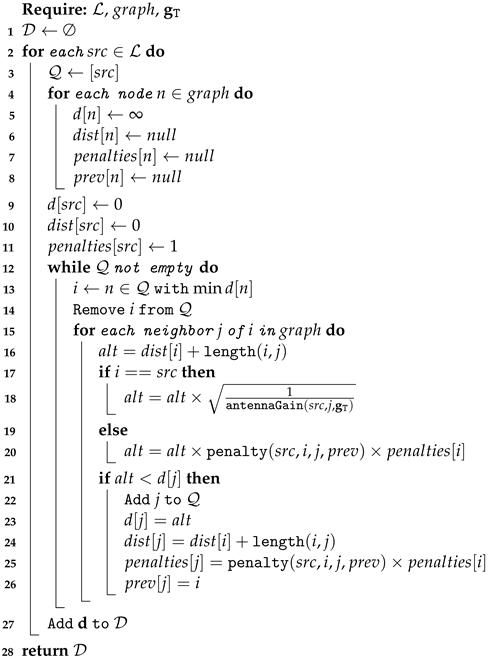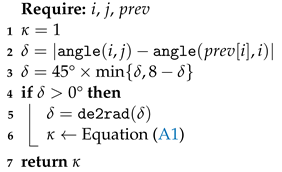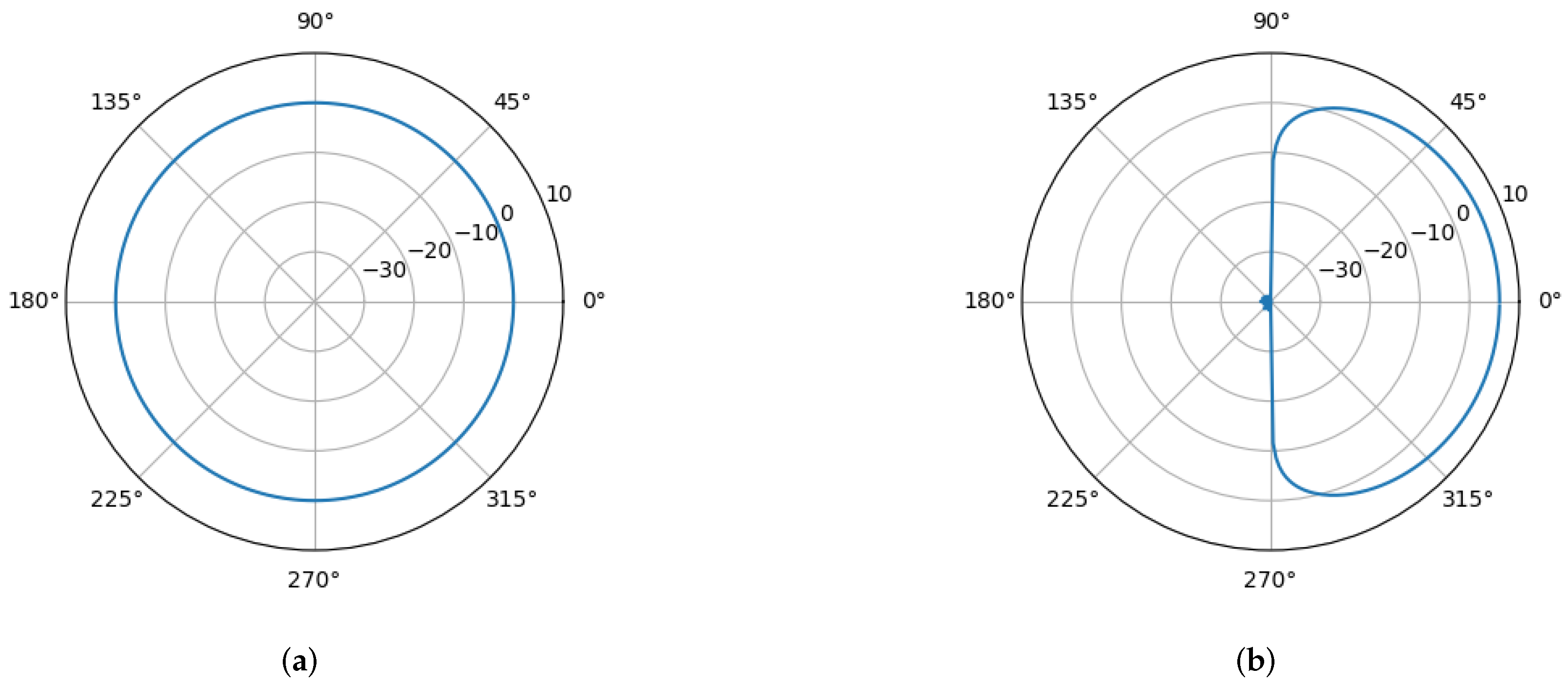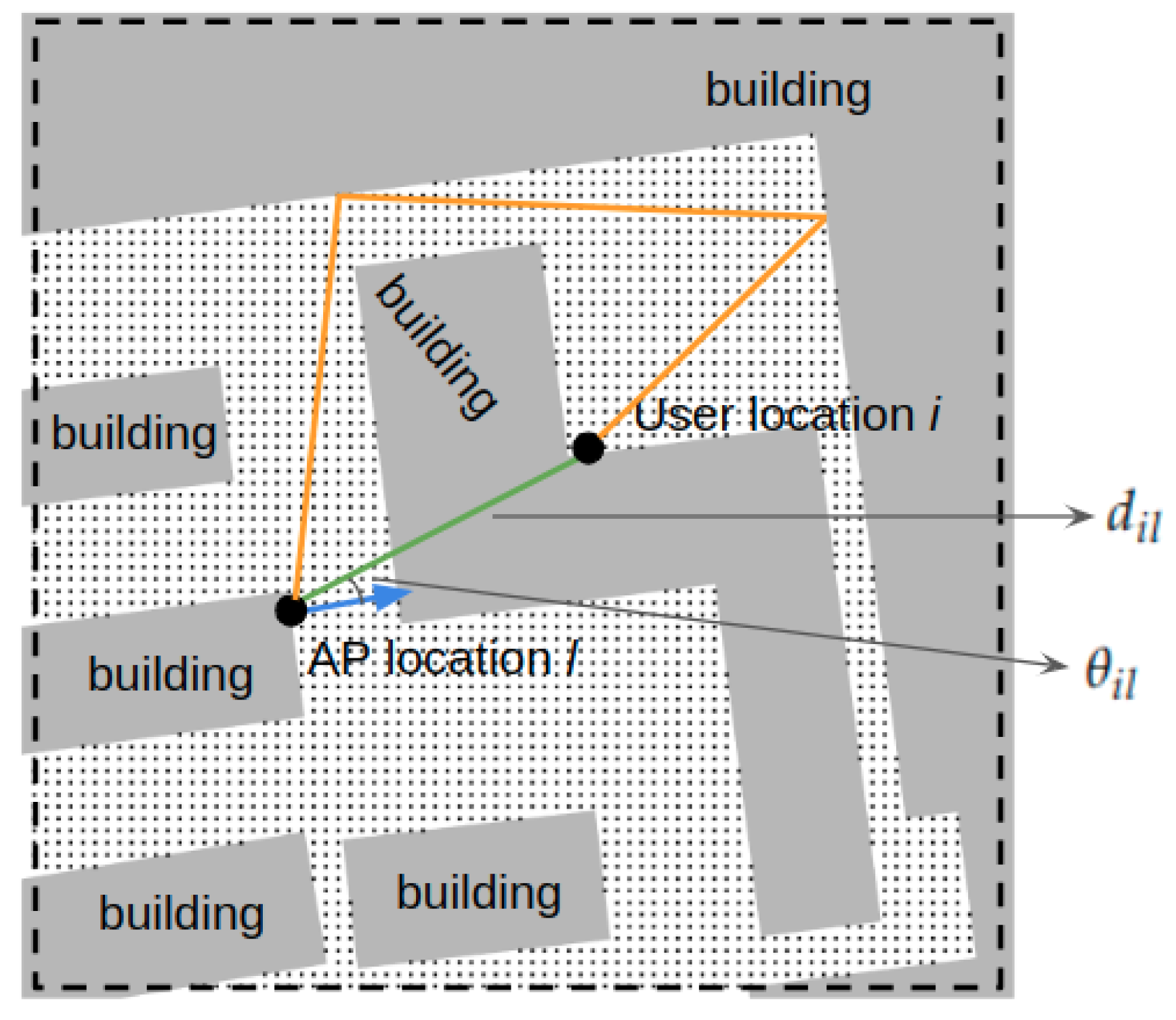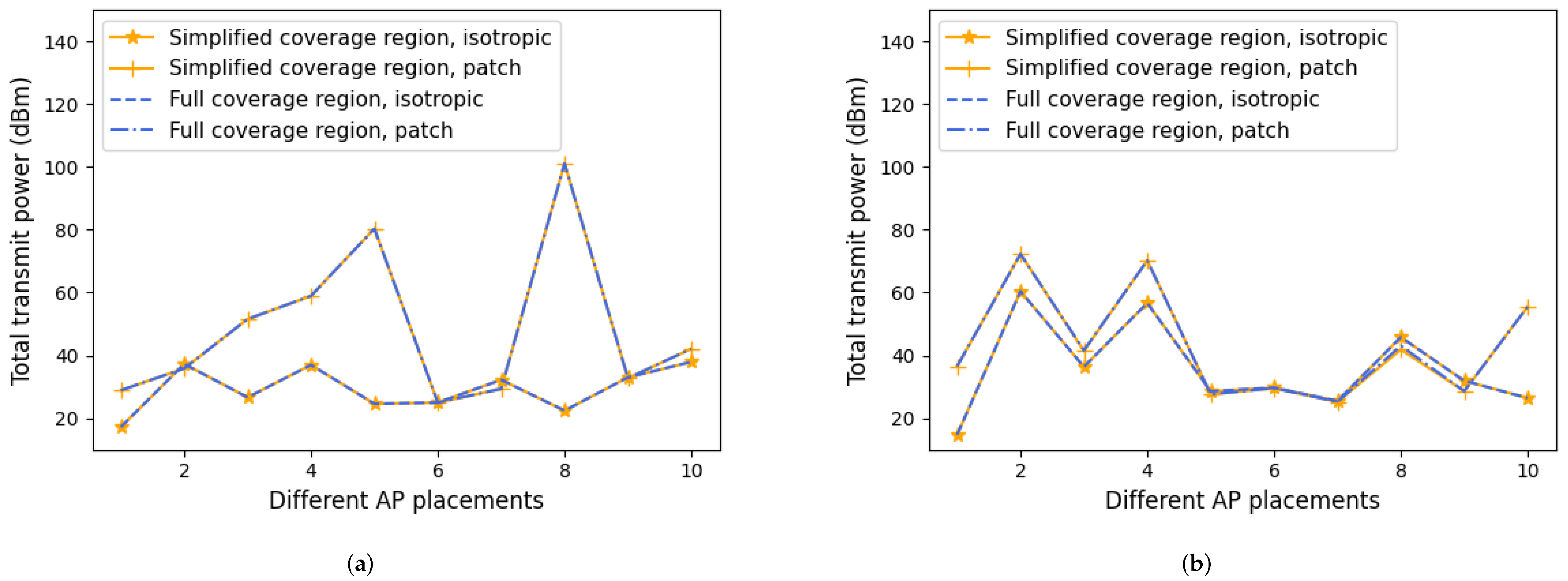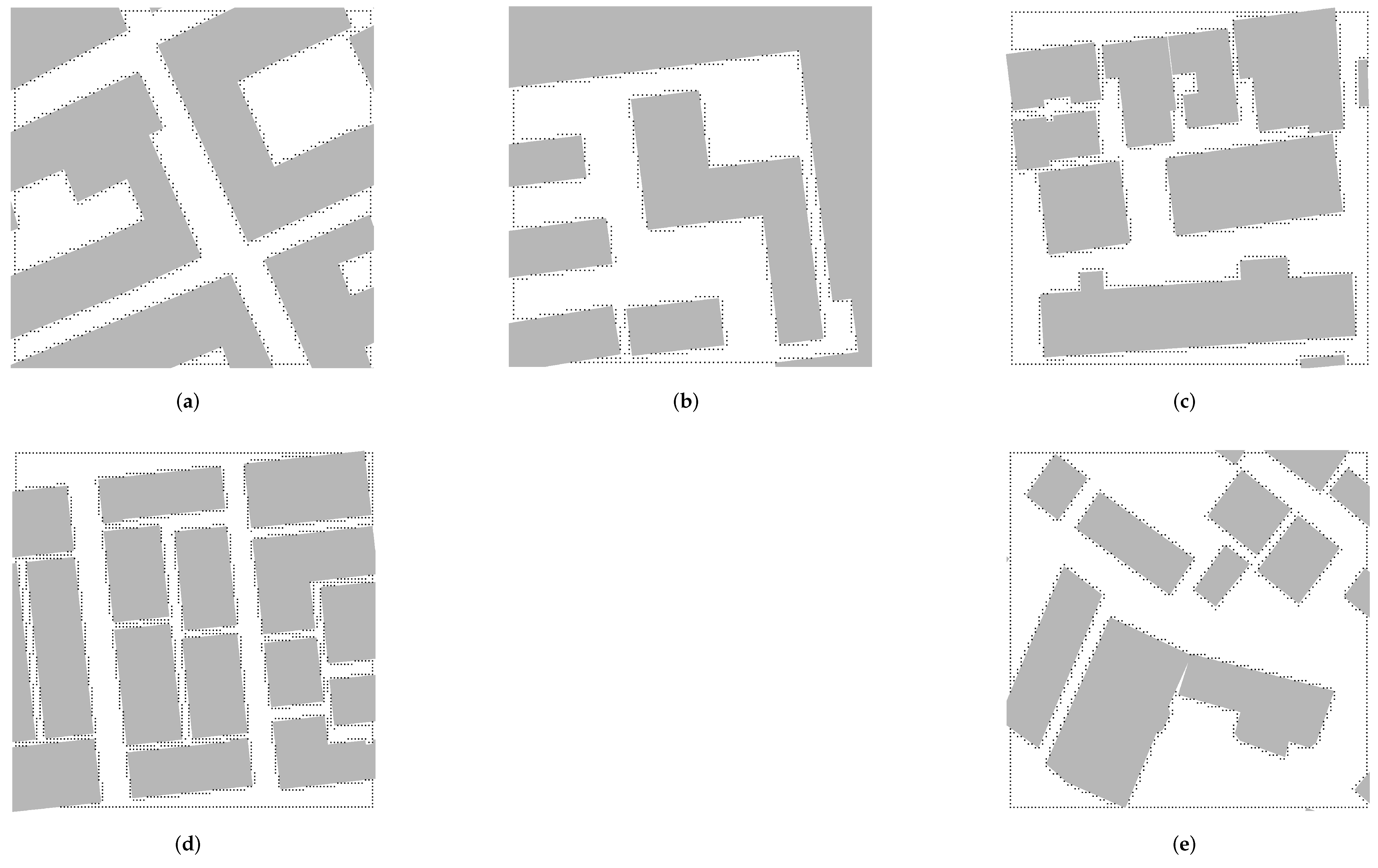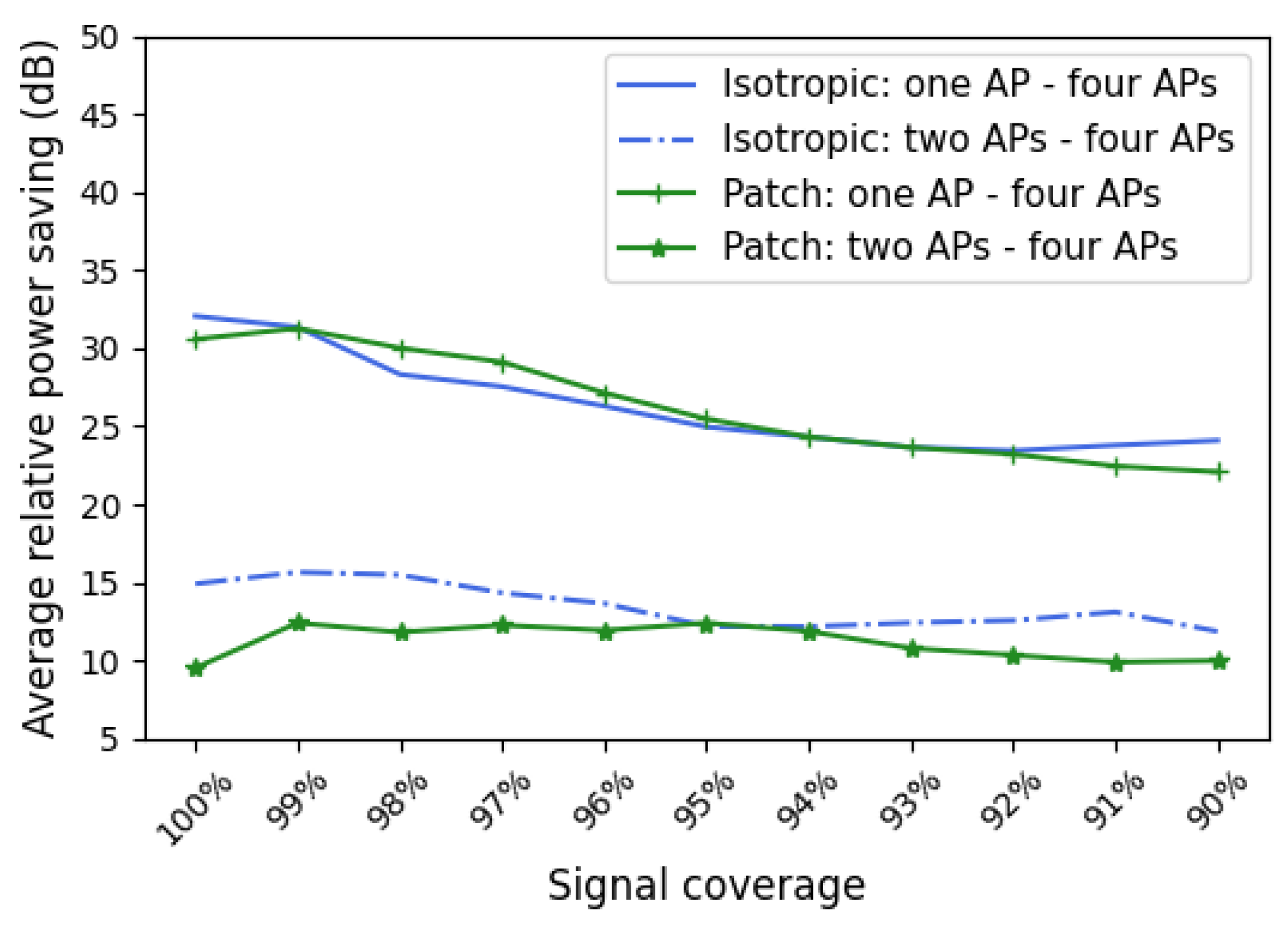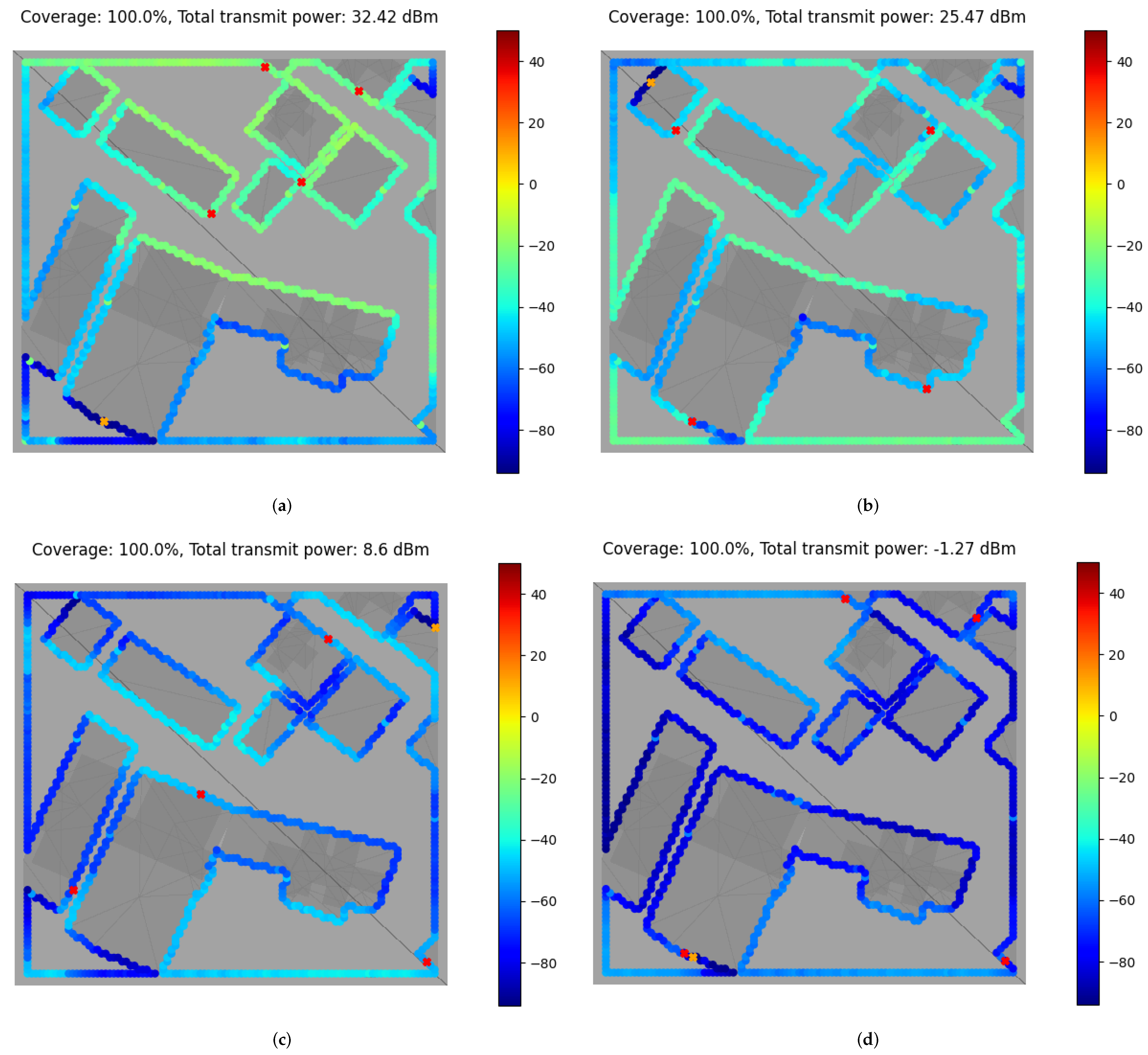1. Introduction
Distributed massive multiple-input multiple-output (D-mMIMO) is a technology that incorporates both the massive multiple-input multiple-output (MIMO) [
1] and distributed antenna system [
2] concepts. Due to the great potential regarding capacity and energy efficiency, D-mMIMO has been considered a promising technology for the future generations of wireless networks [
3,
4]. A D-mMIMO system deploys multiple access points (APs) that are connected to a central processing unit. By transforming the network from one central AP with a very large array to multiple APs at different locations, the average distance between the users to the nearest AP can be drastically reduced. Consequently, significant transmit power savings can be achieved. The channels of the users to the access infrastructure highly depend on the APs’ locations. Therefore, having a good AP placement is essential for exploiting the potential of the D-mMIMO system [
5]. This paper aims to reduce the transmit power of the downlink by optimizing the AP placement. As an additional benefit, given the reciprocity in the setup, the optimized AP placement will reduce transmit power of the uplink as well.
When optimizing the AP placement, the environment information is an important parameter. It provides insight on two key aspects:
- (1)
It includes information about the possible locations for deploying the APs.
- (2)
It includes information regarding the objects, e.g., buildings, impacting the channel gain (the average signal power received at a given user when considering unit transmit power and including a potential antenna gain).
Regarding the first aspect, in practical scenarios, e.g., urban areas, APs are conveniently deployed on the walls along the streets or at the roofs’ edges. It is unlikely that APs are deployed, for example, in the middle of a street. The importance of the environment in this perspective may be less evident when the coverage region is large, e.g., 1 km by 1 km. In that case, modifying the generated AP placement by several meters to make the deployment feasible will have little impact on the system’s performance. However, in future wireless networks, the distance between APs and their users is going to shrink drastically due to the increasing AP density [
6]. In this case, the system’s performance becomes very sensitive to the AP placement. Therefore, taking into account the environment information regarding any feasible locations for APs deployment is important. Nevertheless, most existing work is based on assumptions neglecting environment information [
5,
7,
8,
9,
10,
11,
12,
13,
14,
15,
16,
17,
18,
19,
20,
21,
22,
23,
24,
25,
26,
27,
28]. In [
7,
10,
11], the authors considered a distributed antenna system in a cell where all the transmitters and receivers are placed on a line. Another commonly used assumption is the circular topology [
8,
9,
12,
15,
17,
19,
20]. It considers that the APs are placed evenly on a circle. This assumption was initially introduced to make the analysis of the optimization problem tractable [
8]. It simplifies the problem to finding an optimal radius for the circle. A few earlier studies, e.g., [
14,
15,
24,
27], model the problem in a continuous way. They developed different gradient-based heuristic algorithms. Some other researchers applied Lloyd’s algorithm or k-means clustering-based approaches [
11,
18,
21,
25,
28]. To the best of our knowledge, only [
29,
30] take into account the environment information. The focus of these studies, however, is on indoor and underground applications, respectively. This paper focuses on outdoor deployments and takes into account environment information about possible locations for deploying the APs.
Additionally, environment information regarding the possible AP locations is an essential prerequisite when considering the radiation pattern of the arrays. In the literature, the radiation pattern of the arrays in the APs is often ignored or assumed to be isotropic, which is not realistic: even the radiation pattern of antenna arrays with dipole elements is typically very directional in practice [
31]. We have observed in our earlier work [
5] that the radiation pattern has a significant impact on the optimal AP placement. To incorporate the radiation pattern, we need to take into account the broadside direction of the arrays at different locations, which critically depends on the environment of the AP locations. When deploying an AP on a wall, the AP can be installed in a less visible way [
32] and catch less wind, for aesthetics and deployment simplicity. The broadside direction of the array will be perpendicular to the wall and towards the street. In this paper, we consider different antenna types for the array and we deploy the APs on the walls of buildings.
For the second aspect, the obstacles in the environment, e.g., buildings, have a significant impact on the channels. The channel models applied in the current literature for optimizing the AP placement take a limited amount of environment information into account [
8,
9,
10,
11,
12,
13,
14,
15,
16,
17,
18,
19,
20,
21,
22,
23,
24,
25,
26,
27,
28]. Specifically, large-scale fading is usually modeled based on certain statistical distributions and the Euclidean distance between user locations and APs. Those models work well for the traditional cellular systems where the coverage region is large. In that case, the propagation distance between a base station and a user location is large and can be well approximated by a statistical distribution parametrized by the Euclidean distance. However, as coverage regions become small, the discrepancy between the propagation distance and Euclidean distance becomes significant, and empirical propagation conditions are highly location-specific. Therefore, those statistical models are no longer appropriate.
As suggested by [
33], a propagation model which is based on real-world geographic information is indispensable for realistic optimization of the AP placement. In [
33], the authors model the propagation environment using a ray-tracing simulator (RTS) together with an iterative procedure for the AP placement optimization. An RTS considers multipath radio propagation as rays, taking into account different radio propagation mechanisms, namely reflection, scattering, and diffraction [
34]. Therefore, an RTS is able to accurately simulate the channel gain considering the impact from the environment. However, using an RTS for channel evaluation is computationally intensive [
34], especially if this has to be done for many potential AP locations and mobile users that may be anywhere in the coverage zone. Therefore, it is not scalable to apply an RTS for the AP placement optimization. The impact of buildings on the channel gain is also considered by [
35,
36] where different pathloss exponent values for different scenarios together with the Euclidean distance are utilized. However, estimating the pathloss exponent values for a large number of scenarios is a cumbersome task. In this paper, we introduce a graph-based approach to effectively capture environment information. Given that planning the AP placement is a strategic level decision, elements in the environment that move or change within short time intervals, e.g., cars, are not considered.
As illustrated in
Figure 1, this study focuses on the modeling part of the AP placement optimization problem.
The contributions of this paper are as follows:
We formulate the AP placement optimization as a combinatorial optimization problem. This opens a new door for tackling the AP placement problem. Many combinatorial optimization techniques such as integer programming [
37] or meta-heuristics [
38] can be utilized for solving the actual problem.
We propose a graph-based approach for modeling the physical propagation. The approach effectively captures the obstacles in the environment and radiation pattern of the arrays, taking into account the possible broadside direction of the arrays at different potential AP locations.
Based on an RTS, provided by Huawei Technologies (Gothenburg, Sweden), we perform a numerical validation of the graph-based approach and the channel models that have been introduced in the literature, considering different signal coverage levels and antenna types. We demonstrate that it is essential to take into account the radiation pattern of the arrays and environment information regarding the possible user locations, AP locations, and radio wave propagation.
The rest of the paper is structured as follows.
Section 2 details the considered D-mMIMO system and formally describes the problem.
Section 3 presents different ways to model the channel gain, including our proposed graph-based approach as well as others mentioned in the literature.
Section 4 discusses the simulation results and
Section 5 concludes the paper.
Notation: An upper case letter in the default math font, e.g., V, represents a constant. An upper case letter in mathcal font, e.g., , is a set. Indices are denoted only using subscripts in lower case, e.g., l in . Vectors are denoted by lower case letters in bold, e.g., . The complex conjugate is denoted as . The 2-norm of a vector is denoted as . The integer part of a value is denoted by . The total number of elements in a set, e.g., , is denoted as . The imaginary unit, , is represented by , and statistical expectation is denoted by .
4. Simulation Results
In this section, six questions are investigated:
- Q1:
Where are the user locations that have a high impact on the total transmit power?
- Q2:
With the optimized AP placement, what is the relation between the total number of APs and the performance of the D-mMIMO system?
- Q3:
Is it important to take the radiation pattern of the arrays into account when optimizing the AP placement?
- Q4:
Is it essential to take more environment information into account when optimizing the AP placement?
- Q5:
Does the angular penalty-based model perform better than the Euclidean distance-based model?
Our analysis considers five distinctive maps, maps 1–5, which are discussed in
Section 4.1, and two scenarios with different antenna elements.
- Scenario I:
isotropic antennas are used in each AP.
- Scenario II:
patch antennas are used in each AP.
For each scenario, 11 signal coverage levels are considered. The parameter setup is summarized in
Table 2.
Figure 7 illustrates the procedure for executing the experiments. For a given channel model, we first use it to generate the average channel gain via Equations (
11), (
14) or (
15). Then the optimal AP placement is generated by solving Formulations (
6)–(9) with the generated
. Noticeably, we always optimally solve Formulations (
6)–(9) regarding the considered solutions space, the set of potential AP locations. In this way, we eliminate the impact of the efficiency of the solver on the results. The approach that is used to solve the formulation is detailed in
Section 4.2. For each generated optimal AP placement, except the ones generated via the RTS-based channel model, we use the RTS-based model to compute the channels, which are regarded as the ground truth. Then the total transmit power (
) for the AP placement is calculated based on the channels generated via the RTS-based model. The experiments are executed on a machine with 20 Intel Xeon(R)W-2155 CPU @ 3.30 GHz processors, one NVIDIA Quadro P6000 GPU, and Windows Server 2016 system.
4.1. Reducing Potential User Locations
The generated user locations are one meter apart, as mentioned in
Section 2. The total number of the generated user locations is large. Considering a 100
by 100
coverage region, for example, the total number of the user locations within the coverage region is more than 5000, which results in a long computational time when running the RTS to validate the AP placements. This motivates us to find a way of reducing the total number of user locations.
We hypothesize that, for a given user location that is fully surrounded by eight user locations, the user location will surely receive sufficient power if the other eight locations have received sufficient power. This implies that we only need to consider the signal coverage for locations that are not fully surrounded by other locations. The user locations, which are either next to a building or on a boundary of the considered coverage region, are the essential user locations. To test this hypothesis, we calculate the total required transmit power via the RTS-based model using a four-ap D-mMIMO system for 10 randomly generated AP placements. Two antenna types and two maps are considered. The targeted signal coverage level is 100%.
The result of this simulation is illustrated in
Figure 8, where a full coverage region means that all the user locations are included, while a simplified coverage region only includes essential user locations.
Figure 9 gives an example for the heatmaps of the average received signal power
in dBm at each location when considering an AP placement on map 1. The red spots in
Figure 9 represent the APs, and the orange spot indicates the user location that receives the overall lowest power. The results in
Figure 8 and
Figure 9 confirm that the total transmit power and the user location that receives the overall lowest power for each AP placement remain very similar when we consider a full coverage region or simplified coverage region. This implies that most of the essential locations have been included in the simplified coverage regions.
The required computational time is given in
Table 3, demonstrating that the simplified coverage region results in a 4 to 8 times lower computational time compared to the full one. Therefore, we use the simplified coverage regions approach in RTS experiments and when solving Formulations (
6)–(9).
Figure 10 illustrates the simplified coverage regions for the five maps, generated as follows. The data of a selected region is exported from OpenStreetMap. The RTS is used to generate the coverage region, adding 2
’s padding around each map for easier processing of the buildings on the map. Then we keep 3
’s margin between the borders of the map and the coverage region.
4.2. Reducing Potential AP Locations
We aim to find the optimal AP placement with the RTS as a benchmark to evaluate the solutions obtained by using the other channels models. Therefore, we evaluate all the channels for each potential AP location. However, the RTS still requires around 400
to simulate the channels for each potential AP location, resulting in several days to compute the channels for all the potential AP locations in one coverage region. Therefore, we reduce the total number of analyzed AP locations to 100 by selecting one location every
locations. Hence, the set of the 100 selected locations, denoted by
, has a similar distribution as the AP locations in
. We further also use the
in Formulation (
6)–(9), which allows us to enumerate all the possible solutions in around one minute. Therefore, we simply solve the problem by the enumeration procedure instead of a more sophisticated solver.
Noticeably, the reason for reducing the potential AP locations is because the RTS is computationally not scalable. The latter does not apply to the novel approaches presented in this paper.
4.3. Analysis with Perfect Environment Information
In this section, we investigate Q2 and Q3, which are related to the total number of APs in the D-mMIMO system and the radiation pattern. We do the analysis using the RTS-based model instead of the other models for the AP placement optimization. In this way, we eliminate the impact of imperfect environment information on the results. The relevance of environment information regarding the channel gain is further analyzed in
Section 4.4.
4.3.1. Impact of the Number of APs in the D-mMIMO
We consider a D-mMIMO system with 128 antennas in total (see
Table 2). We assume that each AP has the same number of antennas. This section investigates the question of how to decide on the number of APs in the system. We generate optimal placements via the RTS-based model for three cases: (a) four APs, (b) two APs, and (c) one AP.
The average relative power saving between different configurations over all the maps is illustrated in
Figure 11. For example, the full blue line in
Figure 11 represents the average relative power saving of using the system with four APs compared with the system with one AP, using isotropic antennas. The results show that the total number of APs has a huge impact on the system’s performance. The system achieves the best performance when it has four APs. On average, it saves around 22–32
transmit power compared with the one-AP system and 9–15
power compared with the two-AP system. In future research, it may be interesting to study potential further enhancements by deploying more APs.
4.3.2. Value of Radiation Pattern Information
In most of the current literature on optimizing the AP placement, the radiation pattern of the arrays is assumed to be isotropic, which is, however, unrealistic. This section analyses how power savings are impacted by taking the radiation pattern into consideration. We consider a D-mMIMO system with four 32-element APs. All antenna elements are patch antennas. Two sets of AP placements are generated for each of the five maps. The solutions in set 1 are generated without considering the radiation pattern, while set 2 takes into account the patch antennas. The solutions in set 2 and set 1 are compared in
Figure 12, demonstrating an average power saving ranging from 15
to 24
. This confirms the significance of taking into account the radiation pattern of the antennas, consistent with [
5].
As mentioned in
Section 1 considering environment information regarding the potential AP locations is a preposition of considering the radiation pattern. Therefore, the results also imply that it is essential to consider environment information for the AP placement optimization problem.
4.4. Different Channel Models
This section assesses Q4 and Q5. We analyze the value of environment information regarding channel gain for the AP placement optimization. We also compare our proposed channel models with the Euclidean distance-based model, which is commonly used in the literature. We consider a four-AP D-mMIMO system and four channel models discussed in
Section 3. The heatmaps for the received power simulated via the RTS when using the AP placement generated by the different channel models for map 5 are illustrated in
Figure 13. The heatmaps suggest that the Euclidean distance-based model, which represents the commonly applied model in the literature, generates a low-quality AP placement compared with the other models. The main reason here is that the Euclidean distance-based model ignores the building blocks when estimating the angle of departure for the arrays.
Figure 13 demonstrates that environment information is very important when considering the radiation pattern of the arrays.
The average relative power saving when using the shortest path-based model, angular penalty-based model, and the RTS-based model compared with the Euclidean distance-based model over all the maps is illustrated in
Figure 14. The result in
Figure 14a, for example, corresponds to the scenario where we use isotropic antennas.
In general, the power saving in
Figure 14 is higher when using patch antennas instead of isotropic antennas. This is consistent with the results in
Figure 13. Additionally,
Figure 14 indicates that the setup generated via the RTS-based model requires the least power compared with the setups found with other models (for all the scenarios). It saves around 20
compared with the Euclidean distance-based model. This is expected given that the RTS-based model is regarded as the ground truth in this paper. It accurately captures environment information. The results further confirm the importance of considering environment information regarding channel gain for the AP placement optimization.
As mentioned in
Table 3, the RTS-based model requires around 1000–2000 s to evaluate all the channels for each AP placement in a simplified coverage region.
Table 4 lists the average time that is required for different channel models to evaluate the channels for all the possible AP placements in a simplified coverage region. As shown in
Table 4, the RTS-based model requires very long computational time. Therefore, it is interesting to consider the other models for the AP placement optimization. The two graph-based models: the shortest path-based model and the angular penalty-based model are proposed in this work. These models take around one minute to generate the average channel gain
for all the possible AP locations. As suggested by
Figure 14, using the AP placements generated via the two graph-based models, particularly, the angular penalty-based model, power saving is achieved compared with the Euclidean distance-based model in most situations. The average relative power saving of using the angular penalty-based model is around 5
compared with the Euclidean distance-based model. This is consistent with the fact that the two graph-based models contain more environment information than the Euclidean distance-based model. The results in
Figure 14 also suggest that, in general, the angular penalty-based model performs better than the shortest path-based model. This implies that it is important to take the pathloss due to scattering into account when optimizing the AP placement.
Moreover,
Figure 14 indicates that the average relative power saving is correlated with the coverage level. The reason is that the required power at a coverage level is determined by the location which receives the lowest power among all the covered locations. The location is more sensitive to the local environment when the coverage level is high. So, it requires a channel model to include more local environment information to accurately find the particular location when the coverage level is high. This explains why the performance of the Euclidean distance-based model and the two graph-based models is dependent on the coverage level.
5. Conclusions
In this paper, we focus on reducing the transmit power of a D-mMIMO system by optimizing the AP placement. Although we have only considered the downlink, given the reciprocity between downlink and uplink, the optimized AP placement will also relax transmit power requirements for the users. We formulate the AP placement problem as a combinatorial optimization problem. A simplified coverage region is applied, which results in significantly less computational time while having little impact on the solutions. With this approach, we have analyzed the performance of the D-mMIMO using an RTS-based model for optimizing the AP placement. Different antenna types and signal coverage levels are considered. Our results have demonstrated the significance of environment information, feasible locations for deploying APs and radiation patterns, which are commonly neglected in the existing studies. The consideration of the radiation pattern leads to a power saving of around 15–24 dB. Furthermore, using four APs instead of one or two APs in the system brings a power saving of more than 22 and 9 , respectively. Additionally, a power saving of around 20 is achieved by evaluating the channels with perfect environment information. The RTS-based model precisely captures environment information and generates a very good AP placement, however, it is computationally intensive and not scalable. For this reason, we have introduced a graph-based approach to effectively approximate the channel gain. The performance of this approach has been evaluated via the RTS. The results show that the graph-based approach saves around 5 power compared with the Euclidean distance-based approach, which represents the commonly applied model in the literature.
Nevertheless, this work has some limitations which can be addressed in future work. The gap between the transmit power when using the graph-based approach and using the RTS-based model is still large. Therefore, the graph-based approach requires further improvement. This may be achieved by applying some ideas from existing geometric models, e.g., [
44]. In addition, we assume that all the system’s APs jointly serve each user. However, this is computationally intensive in practice. It would be necessary to investigate the tradeoff between computational effort and energy efficiency regarding the total number of APs that jointly serve each user out of all the APs in the system. Other than these, we assume the signals from different APs are combined coherently at each user location, which is an ideal case. It is also worthwhile to check the performance of the graph-based approaches in the worst case where signals are combined non-coherently at each user location. Finally, this work does not focus on the solver development for the AP placement optimization problem, yet has formed a bridge between the problem and the combinatorial optimization. Combinatorial optimization techniques can be explored in the future to develop an efficient solver for the problem.
